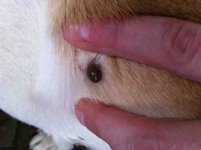porkysmamma
New member

Woke up scratching Porkys chest like I usually do n I find this
Follow along with the video below to see how to install our site as a web app on your home screen.
Note: This feature may not be available in some browsers.

 things!
things!EEEEEEEEEEEEEEEEEEEEeWWWWWWWWWWWWWWWWWWWWWWWWWW! sorry, no clue how to get it out
looks like the wood tick. deer ticks are smaller and have a design on their backs. dig it out or wait until it turns into a pimple and then you can get it out too
There isn't even a bump, hole nothing I wouldn't know where it was if it wasn't for the big oil stain in her fur (vet told me oil will drown n lubricate lol) I may shave the area though just to be safe :/ poor baby anytime she gets an owie I shave it lol
@porkysmamma
I just went through this with Blue on Monday. His was an adult male deer tick that he picked up in Jersey this weekend, probably Sunday.
According to the NYS Department of Health, "The three most common ticks in New York State are the deer (black-legged) tick, the American dog tick and the lone star tick." http://www.health.ny.gov/publications/2813/
Based on all the pics I was pouring over this Monday, yours looks like an engorged female Deer tick. And here a link to pics of various ticks. http://www.lymediseaseassociation.o...m_phocagallery&view=category&id=40&Itemid=425
I contacted my vet and she said to watch for the usual symptoms- lethargy, lameness.
[MENTION=5186]porkysmamma[/MENTION]
I just went through this with Blue on Monday. His was an adult male deer tick that he picked up in Jersey this weekend, probably Sunday.
According to the NYS Department of Health, "The three most common ticks in New York State are the deer (black-legged) tick, the American dog tick and the lone star tick." http://www.health.ny.gov/publications/2813/
Based on all the pics I was pouring over this Monday, yours looks like an engorged female Deer tick. And here a link to pics of various ticks. http://www.lymediseaseassociation.o...m_phocagallery&view=category&id=40&Itemid=425
I contacted my vet and she said to watch for the usual symptoms- lethargy, lameness.